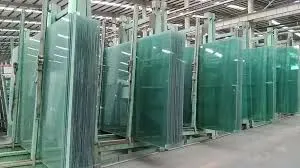The demand for 5mm float glass has seen a significant uptick, driven by its versatility in various applications ranging from architectural projects to decorative purposes. As the market evolves, understanding the pricing dynamics and factors affecting 5mm float glass is crucial for industry professionals and buyers alike.

Float glass, recognized for its perfectly uniform thickness and high clarity, is manufactured by floating molten glass on a bed of molten tin. Among its various thickness options, 5mm float glass strikes a balance between durability and weight, making it a preferred choice in both residential and commercial constructions. It offers optimal transparency while also providing the structural integrity required for applications like windows, tabletop overlays, and interior partitions.
Several factors contribute to the pricing of 5mm float glass. Supply chain dynamics, including raw material costs such as silica sand, soda ash, and limestone, directly impact the price. Energy costs, pivotal in the glass manufacturing process due to the high temperatures required, also play a significant role. In recent years, fluctuating energy prices have continued to affect glass prices globally.

Another key aspect influencing the price is the regional manufacturing capabilities and market demand. Regions with a robust glass manufacturing infrastructure often benefit from competitive pricing due to economies of scale. Conversely, areas reliant on imports may experience higher prices due to added transportation costs and tariffs. This is particularly significant in the context of global market shifts and trade regulations that influence import-export dynamics.
5mm float glass price
Innovation within the float glass industry has also been a driver of price variations. Enhanced processing techniques such as coating technologies have led to the development of low-emissivity (Low-E) and solar control glass, highly sought after for energy-efficient buildings. While these innovations can result in premium pricing, they also offer long-term cost savings through energy conservation, making them an attractive option despite the initial investment.
From an expertise standpoint, engaging with reputable suppliers who provide transparency regarding sourcing and manufacturing processes can mitigate the risk of inflated prices. Experienced suppliers offer insights into market trends, enabling buyers to make informed decisions aligned with their specific needs. Furthermore, the certification of glass quality standards, such as ISO 9001 and CE marking, assures buyers of the product's reliability, contributing to the trustworthiness of a supplier.
As the demand for sustainable construction materials grows, environmentally friendly manufacturing practices are increasingly prioritized. Manufacturers employing recycling and waste reduction methods often highlight these initiatives as part of their value proposition. Buyers who emphasize eco-friendly practices can often find opportunities for competitive pricing, aligning their purchasing decisions with broader sustainability goals.
In conclusion, understanding the multifaceted aspects of 5mm float glass pricing requires an appreciation of both micro and macroeconomic factors. Professionals in the field must stay informed about global industry trends, supply chain developments, and technological advancements to navigate pricing effectively. By building relationships with authoritative suppliers and prioritizing quality standards, buyers can ensure that they secure high-value glass products tailored to their requirements, maintaining a balance between cost, quality, and environmental considerations.
 Afrikaans
Afrikaans  Albanian
Albanian  Amharic
Amharic  Arabic
Arabic  Armenian
Armenian  Azerbaijani
Azerbaijani  Basque
Basque  Belarusian
Belarusian  Bengali
Bengali  Bosnian
Bosnian  Bulgarian
Bulgarian  Catalan
Catalan  Cebuano
Cebuano  Corsican
Corsican  Croatian
Croatian  Czech
Czech  Danish
Danish  Dutch
Dutch  English
English  Esperanto
Esperanto  Estonian
Estonian  Finnish
Finnish  French
French  Frisian
Frisian  Galician
Galician  Georgian
Georgian  German
German  Greek
Greek  Gujarati
Gujarati  Haitian Creole
Haitian Creole  hausa
hausa  hawaiian
hawaiian  Hebrew
Hebrew  Hindi
Hindi  Miao
Miao  Hungarian
Hungarian  Icelandic
Icelandic  igbo
igbo  Indonesian
Indonesian  irish
irish  Italian
Italian  Japanese
Japanese  Javanese
Javanese  Kannada
Kannada  kazakh
kazakh  Khmer
Khmer  Rwandese
Rwandese  Korean
Korean  Kurdish
Kurdish  Kyrgyz
Kyrgyz  Lao
Lao  Latin
Latin  Latvian
Latvian  Lithuanian
Lithuanian  Luxembourgish
Luxembourgish  Macedonian
Macedonian  Malgashi
Malgashi  Malay
Malay  Malayalam
Malayalam  Maltese
Maltese  Maori
Maori  Marathi
Marathi  Mongolian
Mongolian  Myanmar
Myanmar  Nepali
Nepali  Norwegian
Norwegian  Norwegian
Norwegian  Occitan
Occitan  Pashto
Pashto  Persian
Persian  Polish
Polish  Portuguese
Portuguese  Punjabi
Punjabi  Romanian
Romanian  Russian
Russian  Samoan
Samoan  Scottish Gaelic
Scottish Gaelic  Serbian
Serbian  Sesotho
Sesotho  Shona
Shona  Sindhi
Sindhi  Sinhala
Sinhala  Slovak
Slovak  Slovenian
Slovenian  Somali
Somali  Spanish
Spanish  Sundanese
Sundanese  Swahili
Swahili  Swedish
Swedish  Tagalog
Tagalog  Tajik
Tajik  Tamil
Tamil  Tatar
Tatar  Telugu
Telugu  Thai
Thai  Turkish
Turkish  Turkmen
Turkmen  Ukrainian
Ukrainian  Urdu
Urdu  Uighur
Uighur  Uzbek
Uzbek  Vietnamese
Vietnamese  Welsh
Welsh  Bantu
Bantu  Yiddish
Yiddish  Yoruba
Yoruba  Zulu
Zulu 


